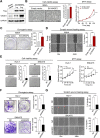Hypomethylation-mediated upregulation of the WASF2 promoter region correlates with poor clinical outcomes in hepatocellular carcinoma
- PMID: 35477411
- PMCID: PMC9047373
- DOI: 10.1186/s13046-022-02365-7
Hypomethylation-mediated upregulation of the WASF2 promoter region correlates with poor clinical outcomes in hepatocellular carcinoma
Abstract
Background: Hepatocellular carcinoma (HCC) is one of the most common and lethal cancers worldwide. Wiskott-Aldrich syndrome protein family member 2 (WASF2) is an integral member of the actin cytoskeleton pathway, which plays a crucial role in cell motility. In this study, we aimed to explore the role of WASF2 in HCC carcinogenesis and its regulatory mechanism.
Methods: WASF2 expression in HCC was analyzed using six public RNA-seq datasets and 66 paired tissues from patients with HCC. The role of WASF2 in normal hepatocyte cell phenotypes was evaluated using a WASF2 overexpression vector in vitro; it was evaluated in HCC cell phenotypes using small interfering RNA (siRNA) in vitro and in vivo. Epigenetic regulatory mechanism of WASF2 was assessed in the Cancer Genome Atlas liver hepatocellular carcinoma project (TCGA_LIHC) dataset and also validated in 38 paired HCC tissues. Site mutagenesis, bisulfite sequencing polymerase chain reaction (BSP), methylation-specific polymerase chain reaction (MSP), and quantitative MSP (qMSP) were used for evaluating WASF2 methylation status.
Results: WASF2 is overexpressed in HCC and is clinically correlated with its prognosis. WASF2 overexpression promoted normal hepatocyte proliferation. WASF2 inactivation decreased the viability, growth, proliferation, migration, and invasion of Huh-7 and SNU475 HCC cells by inducing G2/M phase arrest. This induced cell death and inhibited epithelial-mesenchymal transition, hindering actin polymerization. In addition, WASF2 knockdown using siWASF2 in a xenograft mouse model and a lung metastasis model exerted tumor suppressive effect. There was a negative correlation between WASF2 methylation status and mRNA expression. The methylation pattern of CpG site 2 (- 726 bp), located in the WASF2 promoter, plays an important role in the regulation of WASF2 expression. Furthermore, the cg242579 CpG island in the WASF2 5' promoter region was hypomethylated in HCC compared to that in the matched non-tumor samples. Patients with high WASF2 methylation and low WASF2 expression displayed the highest overall survival.
Conclusions: WASF2 is overexpressed and hypomethylated in HCC and correlates with patient prognosis. WASF2 inactivation exerts anti-tumorigenic effects on HCC cells in vitro and in vivo, suggesting that WASF2 could be a potential therapeutic target for HCC.
Keywords: Carcinogenesis; DNA methylation; Liver neoplasms; Prognosis; WASF2.
© 2022. The Author(s).
Conflict of interest statement
The authors declare that they have no competing interests.
Figures






References
-
- Global Burden of Disease Liver Cancer Collaboration. Akinyemiju T, Abera S, Ahmed M, Alam N, Alemayohu MA, et al. The burden of primary liver cancer and underlying etiologies from 1990 to 2015 at the global, regional, and national level: results from the global burden of disease study 2015. JAMA Oncol. 2017;3:1683–1691. doi: 10.1001/jamaoncol.2017.3055. - DOI - PMC - PubMed
MeSH terms
Substances
Grants and funding
LinkOut - more resources
Full Text Sources
Medical
Molecular Biology Databases
Research Materials

